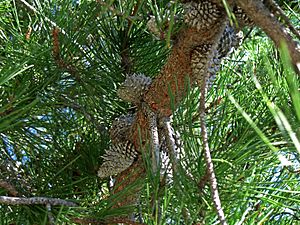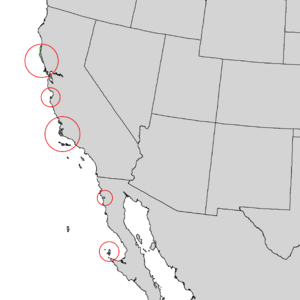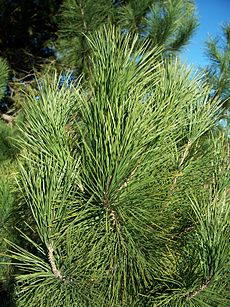Bishop pine facts for kids
Quick facts for kids Bishop pine |
|
|---|---|
 |
|
| Conservation status | |
| Scientific classification | |
| Genus: |
Pinus
|
| Species: |
muricata
|
 |
|
| Natural range of Pinus muricata | |
The bishop pine, also known as Pinus muricata, is a special type of pine tree. It grows in a very small area. You can find it mostly in California, USA. It also lives on some nearby islands and in a few spots in Baja California, Mexico. This tree always grows close to the coast.
In San Luis Obispo County, California, you might see bishop pines alone or in groups. They grow on coastal mountains and hills. Some are found from Morro Bay to Shell Beach. You can also spot them near Avila Beach and in the city of San Luis Obispo. Bishop pines like places where the ground has been disturbed. This helps them avoid competition from other plants like oaks.
The name "bishop pine" came about because the tree was first found near the Mission of San Luis Obispo. This mission is in San Luis Obispo, California. People have given this tree many other names too. Some of these include prickle cone pine, Obispo pine, and Santa Cruz pine.
| Top - 0-9 A B C D E F G H I J K L M N O P Q R S T U V W X Y Z |
About the Bishop Pine Tree
The bishop pine is an evergreen tree that keeps its needles all year. It can grow to be 15 to 25 meters (about 50 to 80 feet) tall. Sometimes, it can even reach 34 meters (about 110 feet). Its trunk can be as wide as 1.2 meters (about 4 feet). Trees growing right on the coast are often smaller and twisted. This tree can handle dry weather and grows well in rocky soil.
The needles of the bishop pine grow in pairs. They are usually green or blue-green. Each needle is about 8 to 16 centimeters (3 to 6 inches) long. The cones grow in groups of one to five. These cones point strongly downwards on the branch. They are 5 to 10 centimeters (2 to 4 inches) long.
The cone scales are tough. They are thin on the side facing the branch. But on the other side, they are very thick and have a sharp spine. These features help protect the cones from squirrels. They also protect the cones from fire damage. The cones stay closed for many years. They only open to release seeds after a fire or very strong heat.
Different Kinds of Bishop Pine
There are two main types, or forms, of Pinus muricata:
- The southern form has bright green needles.
- The northern form has dark blue-green needles.
The sap, or resin, inside the trees is also different between the two forms. The line between these two forms is very clear. It is about 8 kilometers (5 miles) south of the border between Mendocino County and Sonoma County in California. Scientists have tried to mix the two forms. However, they have not been able to create new hybrid trees. This suggests that the two forms might be more different than they look.
Where Bishop Pines Grow
Bishop pines often grow with different kinds of oak and cypress trees. You can find them in the California Coast Ranges. Many other plants also grow beneath them. These include sword fern, salal, and western poison oak.
One special place where bishop pines grow is with Mendocino cypress trees. They form a "pygmy forest" on coastal terraces. This happens in Mendocino County and Sonoma County. One such forest is in Salt Point State Park. In Mexico, the bishop pine is considered an endangered species. This means it is at risk of disappearing.
How People Use Bishop Pines
Bishop pines have been planted in special tree farms. They grow faster there than in the wild. However, this can sometimes affect the variety of plants and animals in the area.
This tree is also grown in parks and gardens because it looks nice. It has even won an award called the Royal Horticultural Society's Award of Garden Merit.
See also
 In Spanish: Pino obispo para niños
In Spanish: Pino obispo para niños




